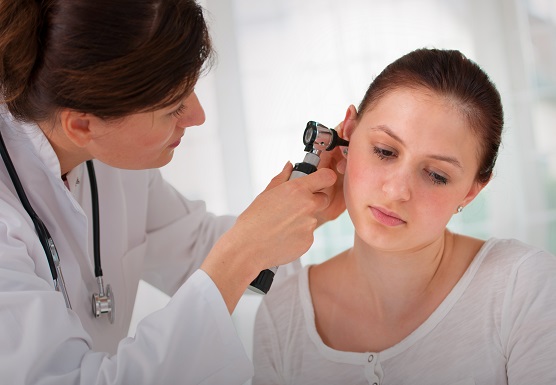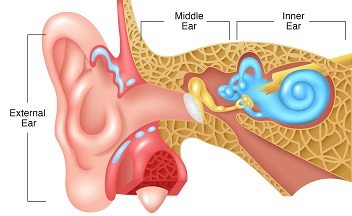
Hearing enables us to develop language and communicate, to experience the joy of music and the ever-present soundtrack of nature, to respond to the cries of those in need, and to flee from sounds of impending danger. Dr David Chin, Consultant ENT Surgeon, ASCENT Ear Nose Throat SG Alvernia, explains how and why hearing loss occurs, and what can be done to prevent it.

TYPES OF HEARING LOSS
Dr Chin explained that problems with hearing may arise from the external, middle or inner ear. When the problem is in the external or middle ear, examination of the ear with an otoscope will usually suffice for a diagnosis. When the ear canal and ear drum appear normal, the problem usually lies with the inner ear.
Common causes of hearing loss arising from the external ear are obstruction with ear wax and external ear infection. If the problem is in the middle ear, this is usually due to middle ear fluid build-up, or an infection. The latter is usually due to infection of the adenoids (especially in children) or sinusitis. However, it can occasionally be a symptom of nasopharyngeal cancer.
The most common type of hearing loss due to the inner ear is degenerative hearing loss caused by ageing, known as presbyacusis.
“Age-related hearing loss happens to everyone. Young children can detect sounds at 20,000 Hz but most adults beyond 30 years cannot,” stated Dr Chin.
Other types of hearing loss are noise induced hearing loss (NIHL); and sudden sensorineural hearing loss (SSNHL), which is defined as a loss greater than 30dB in three contiguous frequencies, occurring over a period of less than three days.
SSNHL has many possible causes including viral infection, head trauma, exposure to drugs and chemicals, and restricted blood flow to the ear. It can also be a complication of several disorders and diseases. If SSNHL is suspected, it is important that the patient is assessed and treated within the first few days of onset, so that causes requiring immediate treatment are identified and addressed.
PERMANENT VS. REVERSIBLE HEARING LOSS
The good news is that hearing loss related to the external or middle ear is usually reversible, according to Dr Chin.
For example, if a patient’s ear canal is completely blocked by ear wax, simply removing it restores normal hearing immediately. If there is fluid in the middle ear, restoration of the normal air-filled environment brings hearing to almost normal levels. Myringotomy and tympanostomy tube insertion (M&T) is one of the most common procedures for middle ear fluid in children. Immediately after an M&T, patients are usually able to hear at the level prior to the development of middle ear fluid. With SSNHL, the majority of patients can expect some improvement if early treatment with steroids is instituted.
WHO IS AT RISK
The most preventable type of hearing loss is noise-induced hearing loss.
“These days, occupations with high levels of noise exposure, such as construction and working in factories, are regulated in Singapore,” shared Dr Chin. “Hearing protection measures, including the wearing of ear plugs or ear muffs, are instituted in the Workplace Safety and Health (Noise) Regulations, 2011.”
Dr Chin shared that other than noise in the workplace, those most at risk of noise-induced hearing loss are those who are exposed to noise in an unregulated setting, most often social.
“Unregulated noise includes exposure to loud music, either live or through ear phones. Even working in a noisy amusement arcade may result in undue exposure to noise. Teenagers and young adults are thus most at risk of this type of hearing insult,” explained Dr Chin.
EARLY PRECAUTIONS
For children in Singapore, compulsory vaccination (especially for measles, mumps and Rubella or MMR) minimises the incidence of congenital hearing loss.
Fortunately, worldwide newborn hearing screening allows for those with possible hearing problems to be identified and helped early.
“Children aged between 3 and 9 years are most at risk for hearing loss from middle ear effusion and infection due to adenoiditis/sinusitis. As this is an important developmental period for speech and social development, hearing loss should be quickly identified and managed,” advised Dr Chin.
LIFELONG PREVENTION
Dr Chin offers these tips for hearing health.
Minimise the risk of external infection
• Avoid behaviours and/or manage conditions that increase the risk of external ear infection, such as digging ears with picks/ear buds.
• If your ear tends to have frequent build-up of wax, consult you doctor or ENT and discuss a plan for maintenance of aural health.
Minimise exposure to noise
• If you use ear phones, do not use an excessively high volume setting. As a rule of thumb, it should not be so loud that a person next to you can hear it.
• Limit periods of noise exposure. For example:
< 4 hours at the level of sound of an average amusement arcade
< 2 hours at a level of sound at a rock concert
• Use hearing protection devices when possible. For example, a musician practicing may choose to use ear plugs/muffs.
Even when the above preventive measures are taken, Dr Chin stresses that cumulative exposure levels of noise will still pose a risk to hearing.
Look after your general health
• Maintain good overall health. An association between diabetes mellitus (DM) and age-related hearing loss has been shown in research, so any measures taken to prevent or manage DM are likely to benefit hearing health.
WHEN TO GO FOR HEARING TESTS
There is no one-size-fits-all recommendation for hearing tests, according to Dr Chin. In some industries with a high risk of noise exposure, workers start hearing screening in their 40s. If there are no risk factors, hearing screening should be done when people start to notice that their hearing is not as good as it used to be.
Some common signs that hearing is beginning to deteriorate include:
• Not hearing so well with competing sound – such as when several people are speaking at the same time
• Having to ask people to repeat what they are saying
• Having to increase the volume of the television or music compared to before
• Not hearing soft sounds well but experiencing discomfort when hearing louder sounds
• People saying that you are speaking too loudly or even shouting all the time
TYPES OF HEARING TESTS
The most common type of hearing test is pure tone audiometry (PTA), which is done in a soundproof room. Hearing for each ear is individually tested by asking the patient to detect if they can hear the sound which is presented to them. The pure tone refers to sounds at specific frequencies from 500 Hz (low sound) to 8,000 Hz (high sound).
For children, special formats for the audiometry are required in order to determine if a sound is heard, because they may be too young to follow instructions reliably.
In addition, a test known as otoacoustic emissions (OAE) is a quick screening that can be done without any voluntary response from the child. In this test, vibrations from the outer hair cells of the inner ear can be recorded in response to stimulation at different sound frequencies.
In special circumstances, hearing is tested using words presented at a specified volume and scoring the percentage of words correctly heard.
‘LISTEN’ TO YOUR HEARING
Since age-related hearing loss is inevitable, and the cumulative effects of exposure to noise affect hearing over the long term, we should all be mindful of our hearing health, especially as we age.
The late deaf-blind activist and author Helen Keller once said, “Blindness cuts us off from things, but deafness cuts us off from people.” Hearing is integral to social connectivity, which is in turn integral to a happy and fulfilled life.
“So, take responsibility for your own hearing,” urged Dr Chin.
Listen to the doctor, and ‘listen’ to your hearing.
Article contributed by Dr David Chin, an accredited doctor of Mount Alvernia Hospital.
Ascent ENT Alvernia Holdings Pte. Ltd.
Mount Alvernia Hospital Medical Centre D #08-63
Tel: 6256 4489
This article is taken from our MyAlvernia Magazine Issue #41. Click here to read the issue on our website or on Magzter.